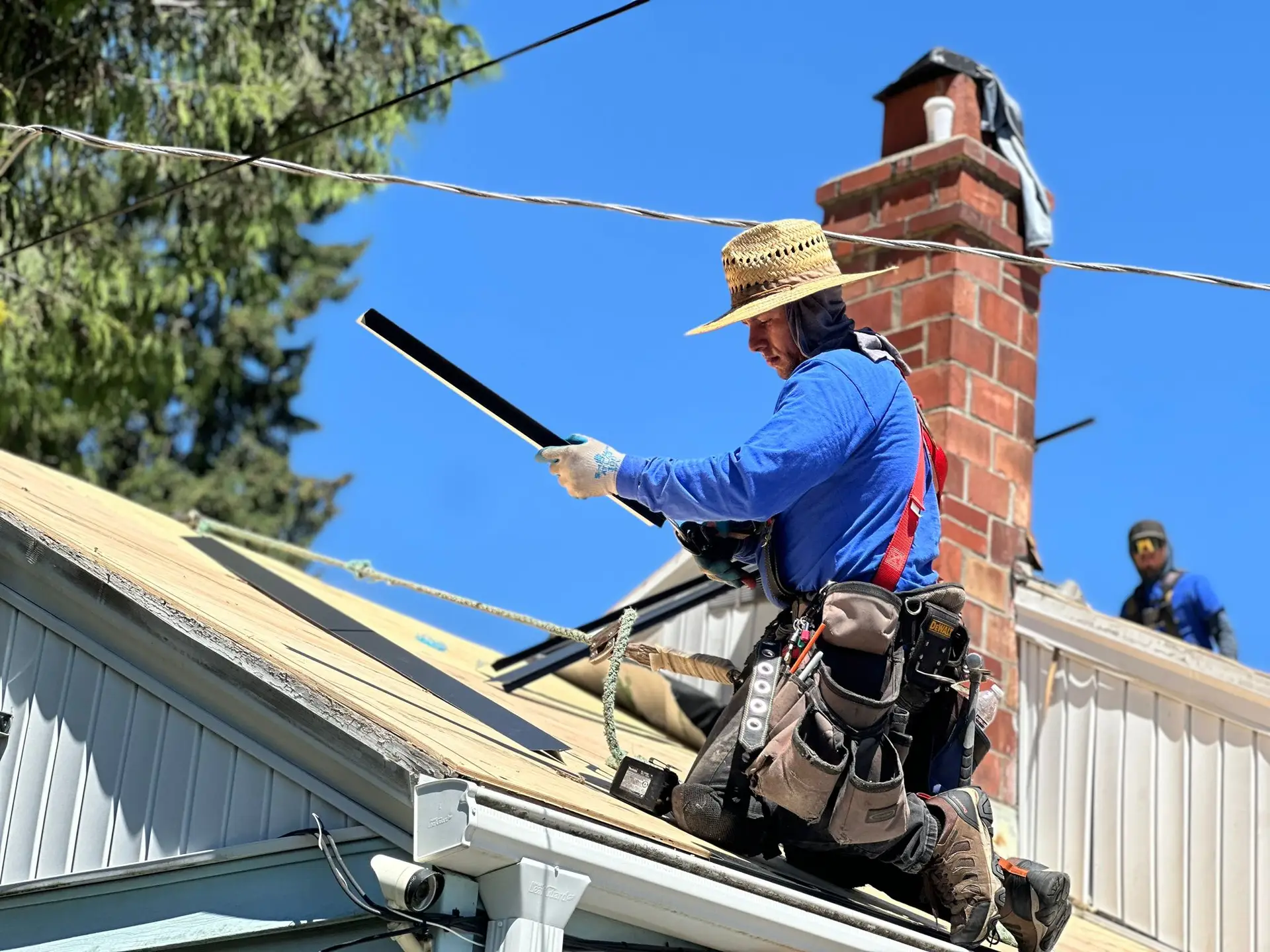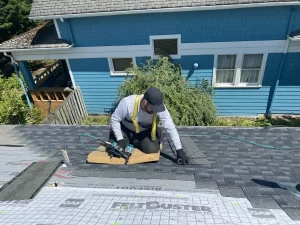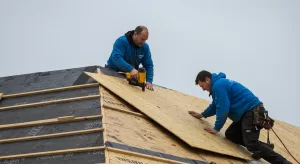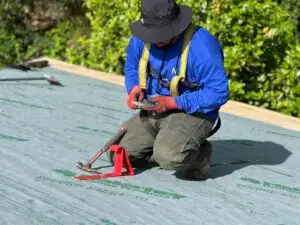When planning a roofing project, deciding on which materials to choose is one of the most important aspects of planning for success. For roof sheathing, CDX plywood and OSB (Oriented Strand Board) are the two major contenders.
But which one is the right choice for your home? CDX plywood and OSB are common roof sheathing materials with key differences in water resistance, cost, weight, handling, and project budget.
OSB is trending because of its lower cost, but many contractors and homeowners still see CDX plywood as the premium, more long-term choice. Beyond price, structural factors also play a part in making the decision, such as each material’s weight and moisture resistance.
So, which option is better for your home? Let’s take a deeper look at how CDX plywood and OSB compare when it comes to moisture resistance, installation considerations, maintenance, and overall performance.
CDX vs OSB: Understanding the Basic Differences
While both CDX plywood and OSB are popular roof sheathing options for good reasons, they are fundamentally different, and to make the right choice for your home, you need to understand the differences.
CDX Plywood
CDX plywood is made with thin sheets (plies) of wood veneers glued together. The grain directions run in alternating (perpendicular) patterns in each layer to give the material maximum strength for load-bearing.
CDX plywood veneers are usually made from softwood such as pine, fir, or spruce. In CDX, the “C” refers to the grade of the face side of the plywood, while the “D” refers to the grade of the back side. The “X” refers to the exterior-grade glue that holds the layers together and is designed to resist moisture and delamination.
However, you should note that despite the “X” in its name, CDX plywood is not fully waterproof, but it can withstand the occasional exposure to moisture.
Oriented Strand Board (OSB)
Unlike plywood layers, OSB is made from wood “strands” or chips that are pressed together and bonded with resins and adhesives. The wood is first cut precisely into strands of roughly 0.5x3x0.02 inches, dried, and blended with binders.
Like plywood, OSB strands are also oriented strategically to give the material added strength. The outer layers are aligned along the strength axis of the panel, and the inner layers run perpendicular to them. The entire construction is then heat-pressed for 4-6 minutes at 650-800 PSI and 400-425°F to form a solid panel.
OSB is made from fast-growing trees with smaller diameters, making it a more renewable and sustainable resource than traditional plywood.
Structural Differences
OSB and CDX plywood behave quite differently because of their structural differences. Plywood’s cross-layering gives it about 10% more rigidity compared to a similar panel of OSB. Plywood is also lighter than OSB of similar dimensions, which makes a big difference in material handling and installation.
However, OSB has its own strengths and, unlike plywood, OSB panels have no internal gaps, which gives it uniform strength across the entire sheet. OSB also doesn’t contain any natural imperfections like knots in the wood, something that’s common in plywood.
But the ability to handle moisture is where most decisions are made between OSB and CDX plywood. Plywood returns close to its original thickness once it dries after being soaked, but OSB tends to remain swollen. This is especially pertinent in areas with a wet climate like Seattle.
Moisture Performance
A sheathing material’s ability to handle moisture is one of the most important aspects to look at when deciding on which material to choose.
Your roof is your home’s first line of defense against the elements, especially moisture. So the way your roof interacts with snow, rain, and melting ice impacts its longevity and structural integrity.
CDX’s Water Absorption and Drying Patterns
Like we mentioned before, the “X” in CDX refers to the exposure rating of the material – the amount of time it can withstand exposure to certain amounts of moisture without losing its structural integrity. This rating also indicates that the material isn’t waterproof, but moisture-resistant.
When CDX is exposed to rain or snow, the veneer layers absorb moisture because of their unsealed nature. However, CDX dries quickly even after getting moist and returns almost completely back to its original dimensions.
Testing CDX for its performance in moist conditions revealed that after 48 hours of soaking, CDX plywood swelled by around 6.9% to 9.2% in thickness. And once it dried, residual swelling was between 2.8% and 5.7%. This highlights plywood’s ability to maintain its dimensional stability during seasonal moisture changes.
OSB’s Response to Prolonged Moisture Exposure
Initially, OSB appears to handle moisture quite well thanks to its adhesives and resins, which seal the panels and block any air holes. This manufacturing technique allows it to repel water at first contact.
However, with prolonged exposure to moisture, once the OSB panel becomes fully saturated, it retains that moisture much longer than CDX. And during this period, your roof is extra vulnerable to problems that arise from water damage, such as leaks and structural issues.
Tests on OSB also revealed concerning statistics: after multiple wet-dry cycles, OSB swells up to 45% of its original size. Compared to CDX, this number is huge!
And an additional issue is that this change is permanent. That’s because extended exposure to water breaks down the bonds between OSB wood strands, and they try to return to their original pre-compressed state before manufacturing. This causes permanent swelling of the wood panels.
Real-World Comparison
Practically, both materials can handle short-term exposure to moisture in everyday situations. CDX retains around 86% of its original strength after wet-dry cycles, while OSB retains between 63% to 70% of its original rigidity.
Being knowledgeable about your local weather and how it impacts the materials you use is also important for making informed decisions for your home. And while neither CDX nor OSB is ideal for constant exposure to moisture, they perform differently in challenging conditions:
- Pressure-treated CDX performs better in damp regions because it can withstand prolonged moisture without damage.
- If you prefer OSB, look for panels with sealed edges, as standard OSB panels are more prone to water seeping inside the material.
Technology also continues to improve the materials we use. For example, specialized plywood like RTD has an absorption rate of just 10-12%.
Installation and Handling
The roof sheathing’s characteristics during installation also have a significant impact on your project’s budget and timeline.
Weight Differences and Ease of Installation
Weight is more than just a number for roofing contractors who have to balance themselves on tricky surfaces and steep slopes nearly 30 feet above the ground.
In this regard, CDX offers a considerable advantage as it weighs about 15-19% less than comparable OSB sheets. Practically speaking, a standard 23/32” 4’x8’ CDX sheet weighs approximately 67 pounds while an OSB sheet of similar dimensions weighs around 78 pounds.
This difference in weight becomes the make-or-break factor for several installation steps, such as carrying the materials up to the roof on ladders, placing the sheets on rafters in windy conditions, and making adjustments after installation.
However, don’t confuse CDX’s lighter weight for lesser structural integrity because, despite being lighter, CDX plywood boasts exceptional strength.
On the other hand, OSB is cheaper, but it’s heavier weight and greater sensitivity to moisture can pose complications during installation. For example, moving OSB sheets to the roof requires more effort and, possibly, more crew. This increases labor costs.
OSB also requires protective coatings or quick covering after installation to prevent swelling if the weather is damp. This adds delays and potential installation steps.
Cutting and Fastening Behavior
Roofing materials in CDX plywood remain more securely attached over time, with a lower risk of flying off during high winds.
However, no matter which material you use, keep the following installation tips in mind:
- Install panels with an 8-foot length perpendicular to the support members
- Leave a ⅛ inch gap between panels to allow for expansion
- Keep a gap of 6 inches at the edges and 12 inches at intermediate supports
- Secure the panels with 8d common nails
Remember, your roof is only as good as the installation. So, make sure that you use proper installation techniques and hire professional roofers to ensure the longevity of your roof.
Cost Comparison
While the technical performance of the material matters, the hole each material burns in your wallet matters too! Let’s take a look at the financial implications of choosing between OSB and CDX plywood.
Price Comparison
If you have a limited budget, you’ll find that OSB is generally 10-20% cheaper than comparable CDX plywood.
For example, in today’s market, 4×8 sheets of OSB cost between $3 to $5 less per sheet compared to ½ inch sheets of CDX plywood. For an average home of 2500 square feet, this could translate to a savings of $700 on material alone. Keep in mind, though, that prices vary based on the grade of the material and the regional availability.
It’s also worth noting that the prices of higher-grade structural OSB are creeping up to match standard CDX plywood prices. This could reduce the economic advantage, but ask yourself this: Is money always the best factor in making a decision?
Lifespan and Replacement Considerations
Properly installed and maintained OSB can last for decades, while CDX can last throughout the roof’s lifespan with just the right installation.
In any case, the life of both materials closely depends on the exposure to moisture and the quality of installation.
Homes with higher exposure to moisture may be better served by CDX and its enhanced drying ability. Think of it as paying slightly higher upfront and avoiding potential replacement costs down the line.
Total Cost of Ownership
Industry experts say that the lighter weight of CDX can reduce labor costs during installation as contractors can work faster and more efficiently with lighter materials.
The average replacement cost is also lower for CDX, especially in humid climates. But in areas with dry weather or lower humidity, the cost-effective OSB is the perfect candidate.
Currently, market research shows that 75% of sheathing material used in homes is OSB. However, some homeowners still view CDX as the premium choice, as it also impacts the resale value of the home if you plan to sell in the near future.
CDX Plywood vs OSB Comparison Table
Here’s a quick comparison table of both of these popular sheathing materials:
| Characteristic | CDX Plywood | OSB (Oriented Strand Board) |
| Composition | Thin wood veneers glued together with alternating grain directions | Compressed wood strands (flakes/chips) bonded with resins and adhesives |
| Weight | 15-19% lighter (67 lbs for 23/32″ 4’x8′ sheet) | Heavier (78 lbs for 23/32″ 4’x8′ sheet) |
| Structural Properties | 10% stiffer than OSB May contain natural wood defects | Uniform strength profile No internal gaps or voids |
| Moisture Response | 6.9-9.2% thickness swelling after 48-hour soak Returns almost to original dimensions after drying Faster drying time | Can swell over 45% after multiple wet-dry cycles Swelling is largely irreversible Longer drying time |
| Strength Retention | Retains 86% of original strength after wet-dry cycles | Retains 63-70% of original stiffness after soaking |
| Installation Characteristics | Cleaner cuts Less dust during cutting Superior screw and nail holding ability | More dust during cutting Standard fastener performance |
| Cost (2025) | Higher cost USD 12.75-13.90 per sheet (varies by grade) | 10-20% less expensive USD 7.85-13.10 per sheet (varies by grade) |
| Lifespan | Can last the lifetime of the roof with proper installation | Can last for decades with proper installation |
Conclusion
Whether you choose OSB or CDX plywood for your roof, make sure to hire a professional roofing contractor with experience in both the material and the local climate, including how the climate affects the roof.
At NearMe Roofing Company, we pride ourselves on offering the best roofing services in Seattle and the entire greater Puget Sound area. We offer flexible financing, the best warranties, and exceptional service. So, schedule a free roof inspection with us and let’s talk about how we can help your roof!





